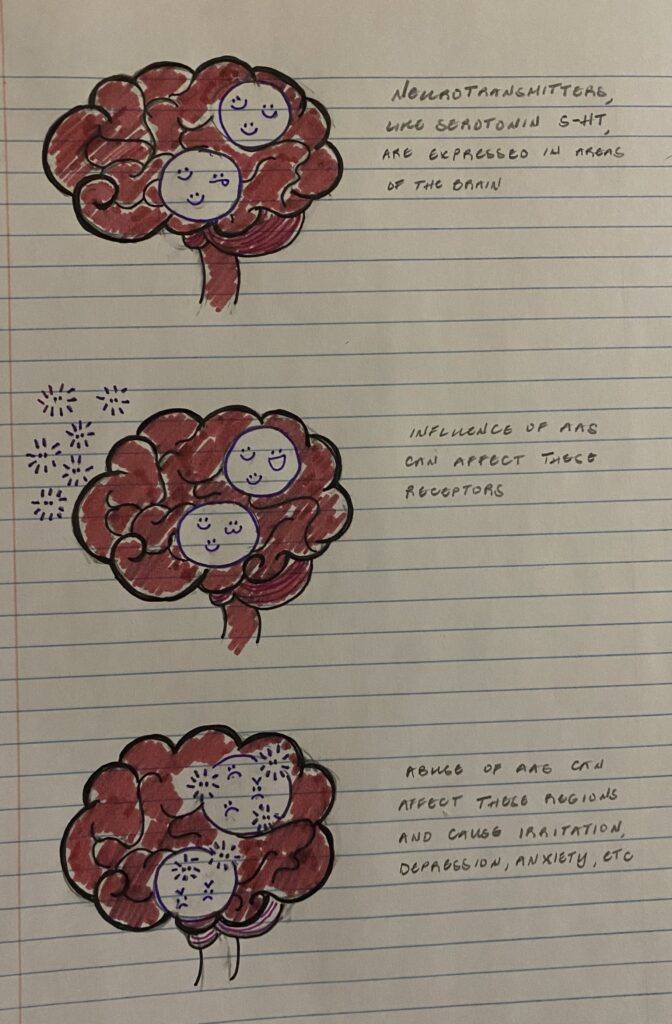The human brain and its nervous system are essential components to understanding the negative impacts that abusing anabolic-androgenic steroids (AAS) can have on the human body. In particular, the neurotoxicity and influence of negative behaviors. There are four main structures of the brain. They are the cerebrum, cerebellum, brainstem, and diencephalon. These structures are important for functions and pathological changes that can be induced by substances such as AAS. In this essay, I will explore how the abuse of AAS can affect the brain and nervous system components, identify brain functions and structures, and give an understanding to the key components of the nervous system.
The cerebrum is responsible for higher cognitive functions and voluntary movements that AAS can significantly impact. Studies have shown that prolonged abuse of AAS use can lead to cognitive impairments and aggression due to altering the neurotransmitters in these systems, to include serotonin (5-HT) receptors in the cerebral cortex and limbic structures like the amygdala (Grimes & Melloni, 2006). The amygdala is critical for emotional regulation and for individuals misusing AAS, it is highly correlated to increase irritability and aggressive behaviors (Grimes & Melloni, 2006).
The cerebellum is primarily associated with motor controls and can interact with other brain regions to influence cognitive thinking and emotion processing. Misuse of AAS disrupts the gamma-aminobutyric acid (GABA) from signaling cerebellar regulation of movements and mental state (Stojko et al., 2023). This means that when AAS disrupts these neurotransmitter pathways, it may alter cerebellar motor and cognitive functions (Stojko et al., 2023). The brainstem’s function is to control autonomic functions such as heart rate and respiration, but it also contains critical pathways. Abuse of AAS is highly influential in these pathways inducing neurotoxicity (Grimes & Melloni, 2006). Neurotoxic effects, such as disrupting serotonin signaling in the anterior hypothalamus and brainstem regions, can contribute to mood disorders like anxiety and depression (Stojko et al., 2023). These disruptions can unfortunately lead to increased chances of cardiovascular complications (Stojko et al., 2023). Some complications can be vascular resistance, high blood pressure, irregular heart rate or even death (Santos et al., 2020).
The diencephalon, which includes the thalamus and hypothalamus, is essential for sensory, motor, and endocrine functions. The hypothalamus is most susceptible to the heavy use of AAS because it disrupts the hypothalamus-pituitary gonadal axis (Grimes & Melloni, 2006). This disruption leads to hormonal imbalances, impaired stress responses, and mood disruptions (Grimes & Melloni, 2006).
Not only does abuse of AAS effect the major brain components, it also has negative effects on the central nervous system and peripheral nervous system. Within the central nervous system, androgen receptor areas, like the hippocampus and amygdala, has shown a reduction in gray matter density and alterations of neurotransmitter receptor activity (Stojko et al., 2023). These effects has caused an accelerations of brain aging, impaired memory, and heighten emotion dysregulation (Stojko et al., 2023). In the peripheral nervous system, the impacts of AAS abuse is demonstrated through the overstimulation of the sympathetic nervous system leading to increased adrenergic reception activity contributing to arrhythmias and hypertensions (Santos et al., 2020). Along my own personal fitness journey, and I’m sure many others, it is a quiet, internal debate on if pursuing anabolic androgenic steroids is worth it. Is it worth altering your body just for a leaner look? Would even work and what would the effects on your body be? Researching this question that has always pegged the fitness community has been very eye opening. It is commonly known that steroids can negatively impact your mood but it can also alter so much more on such a smaller scale. There is still a lot to learn and research in this topic of the abuse of AAS, especially its effects it can have on women.
Works Cited
-Santos, J. P. B., Lacerda, F. B., de Oliveira, L. A., Filho, B. B., Assunção, I. N., Santana, M. G., Gomides, L. F., & Cupertino, M. do C. (n.d.). Neurological consequences of abusive use of anabolic-androgenic steroids.
-Stojko,M.;Nocon ́,J.;Piłat, P.;Szpila,G.;Smolarczyk,J.;Z ̇mudka, K.; Moll, M.; Hawranek, M. Innovative Reports on the Effects of Anabolic Androgenic Steroid Abuse—How to Lose Your Mind for the Love of Sport. Medicina 2023, 59, 1439. https://doi.org/10.3390/medicina59081439
-Grimes, J. M., & Melloni, R. H., Jr. (2006). Prolonged alterations in the serotonin neural system following the cessation of adolescent anabolic-androgenic steroid exposure in hamsters (Mesocricetus auratus). Behavioral Neuroscience, 120(6), 1242–1251. https://doi.org/10.1037/0735-7044.120.6.1242


